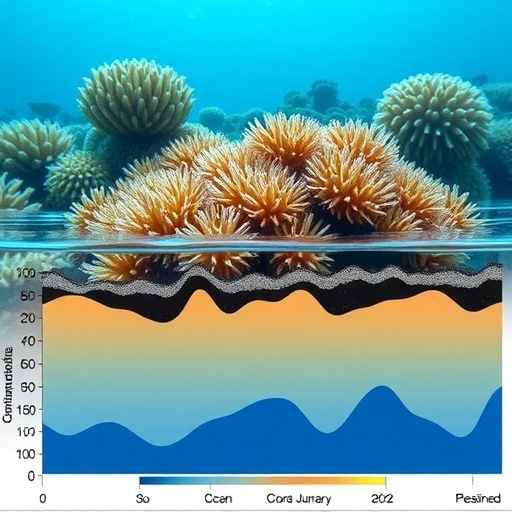Research on coastal ecosystems is increasingly highlighting the critical role that environmental gradients play in shaping biodiversity and species resilience, particularly in coral reefs. A recent study conducted by Doropoulos, Alvarez-Noriega, and Fabricius, along with their colleagues, sheds light on the intricate relationships between juvenile coral demographics and their surrounding environmental conditions. Focusing on the Great Barrier Reef and Torres Strait, this research uncovers vital insights that could inform conservation strategies, enhancing the resilience of these delicate ecosystems amidst growing environmental pressures.
Coral reefs are among the most biologically diverse and economically valuable ecosystems on the planet, often referred to as the “rainforests of the sea.” They provide habitat for a myriad of marine species and support significant economic activities such as tourism and fisheries. However, these ecosystems face myriad threats, including climate change, ocean acidification, and nutrient runoff, which can profoundly affect coral health and survival. Understanding the dynamics of juvenile corals can provide crucial insights into the future of coral reefs, as they represent the potential for population recovery and ecosystem resilience.
The study’s authors employed a multi-faceted approach to assess juvenile coral demography across varying environmental gradients. They meticulously collected data from sites across the Great Barrier Reef and Torres Strait, examining factors such as light availability, water temperature, and nutrient concentrations. By correlating these environmental parameters with juvenile coral distributions and growth rates, the researchers were able to draw meaningful conclusions about how these gradients influence coral health and reproductive success.
One of the key findings of the study indicates a clear relationship between environmental conditions and juvenile coral survival rates. It was observed that coral juveniles in areas with optimal light and favorable thermal conditions exhibited significantly higher growth rates compared to those in harsher environments. This understanding emphasizes the importance of local habitat conditions in mediating the success of coral recruitment and survival, crucial factors for maintaining healthy coral populations.
The implications of these findings extend beyond mere academic interest. As climate change continues to alter marine environments, understanding which conditions favor juvenile corals can guide restoration efforts. For instance, conservationists may prioritize the management of marine areas that exhibit favorable conditions for coral growth, thus optimizing restoration activities and maximizing their chances of success.
Moreover, the study underscores the importance of monitoring not just adult corals, but also juvenile populations, as they are critical indicators of reef resilience. By focusing on juvenile demography, researchers can gain insights into the future viability of coral populations, a crucial aspect for developing effective conservation strategies in the face of changing environmental conditions.
Significantly, the study reveals the interconnectedness of ecosystem health and the demographic patterns of coral juveniles. Coral reefs provide essential ecosystem services, including coastal protection, carbon storage, and supporting marine biodiversity. The research highlights how environmental gradients serve as a double-edged sword: while they can promote biodiversity and resilience in some scenarios, they can also hinder coral survival in others.
Furthermore, this research holds implications for future studies on coral reefs, suggesting that environmental gradients should be a primary consideration when assessing coral health. The findings advocate for a more nuanced understanding of coral ecosystems, prompting researchers to become more mindful of the interplay between juvenile demographics and their environmental contexts.
This comprehensive analysis of juvenile corals and their environmental interactions aligns with current efforts in marine biology to improve the resilience of coral reefs amid climatic uncertainties. The ability of juvenile corals to adapt to changing conditions could serve as a critical indicator of the overall health of these ecosystems, paving the way for more proactive management strategies.
In conclusion, the study by Doropoulos and colleagues offers significant contributions to our understanding of coral reef ecology, particularly concerning the dynamics of juvenile coral populations. As we face essential challenges brought about by climate change and environmental degradation, insights from this research provide a hopeful glimpse into the future of coral reefs, emphasizing the need for targeted conservation efforts and effective environmental management to ensure these vital ecosystems not only survive but thrive.
Subject of Research: Impact of environmental gradients on juvenile coral demography across the Great Barrier Reef and Torres Strait.
Article Title: Impact of environmental gradients on juvenile coral demography across the Great Barrier Reef and Torres Strait.
Article References:
Doropoulos, C., Alvarez-Noriega, M., Fabricius, K. et al. Impact of environmental gradients on juvenile coral demography across the Great Barrier Reef and Torres Strait.
Coral Reefs (2025). https://doi.org/10.1007/s00338-025-02742-6
Image Credits: AI Generated
DOI:
Keywords: Coral reefs, juvenile corals, environmental gradients, demography, Great Barrier Reef, Torres Strait, biodiversity, conservation, climate change, ecosystem resilience.




